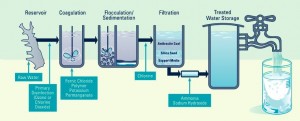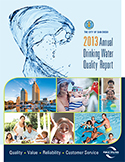
 Every year The City of San Diego publishes a Drinking Water Quality Report about our tap water. You won’t think about tap water the same way again after reading this report!
Every year The City of San Diego publishes a Drinking Water Quality Report about our tap water. You won’t think about tap water the same way again after reading this report!
“The U.S. Environmental Protection Agency and the California Department of Public Health require that all water agencies produce an annual report on the previous year informing customers about the quality of their drinking water.”
– The City of San Diego’s 2013 Annual Drinking Water Quality Report
The most shocking disclaimer of the report is the ‘Is There Anything in My Water?‘ section, which states our water supply may contain Microbial contaminates, Inorganic contaminates, Pesticides and Herbicides, Organic Chemical contaminates, and Radioactive contaminates! California imports 85% of its water from far away. It winds through thousands of miles of unprotected watershed containing towns, farms, old mining sites, and industrial sites before reaching our treatment plants.
“The sources of drinking water (both tap water and bottled water) include rivers, lakes, streams, ponds, reservoirs, springs and wells. As water travels over the surface of the land or through the ground, it dissolves naturally occurring minerals and, in some cases, radioactive material, and can pick up substances resulting from the presence of animals or from human activity. Contaminants that may be present in source water include:
• Microbial contaminants, such as viruses and bacteria that may come from sewage treatment plants, septic systems, agricultural livestock operations, and wildlife.
• Inorganic contaminants, such as salts and metals, that can be naturally occurring or result from urban storm water runoff, industrial or domestic wastewater discharges, oil and gas production, mining, or farming.
• Pesticides and herbicides that may come from a variety of sources such as agriculture, urban storm water runoff, and residential uses.
• Organic chemical contaminants, including synthetic and volatile organic chemicals that are by-products of industrial processes and petroleum production, and can also come from gas stations, urban storm water runoff, agricultural application, and septic systems.
• Radioactive contaminants that can be naturally occurring or be the result of oil and gas production and mining activities.”
– The City of San Diego’s 2013 Annual Drinking Water Quality Report
San Diego’s Water Treatment Process
The City of San Diego’s Water Treatment Process does the best it can to disinfect the imported contaminated water, but it DOES NOT remove these harmful contaminates. Solids are removed from the water, then Chlorine, Ammonia, Sodium Hydroxide, and Fluoride are added to the water before sending it to your tap.
 #1. Primary Disinfection with Ozone or Chlorine Dioxide to inactivate viruses, bacteria, and other pathogenic organisms. (There are Chlorine resistant parasites such as Cryptosporidium and Giardia.)
#1. Primary Disinfection with Ozone or Chlorine Dioxide to inactivate viruses, bacteria, and other pathogenic organisms. (There are Chlorine resistant parasites such as Cryptosporidium and Giardia.)
#2. Ferric Chloride, Polymer, Potassium Permanganate is added to remove dissolved solids.
#3. Chlorine added again for further disinfection.
#4. Water is filtered over Anthracite Coal, Silica Sand, and Support Media to remove small particles.
#5. Ammonia is added (creating Chloramines) to prevent microbial growth, and Sodium Hydroxide is added to correct the pH of the water.
#6. As mandated by California state law, Fluoride is added to the water to ‘promote strong teeth’.
Then it’s sent to your tap.
The California Department of Public Health (CDPH) has a list of some contaminates it requires the City of San Diego to monitor. There are still hundreds of thousands of harmful contaminates that do not require monitoring. The 2013 Annual Drinking Water Quality Report states that during 2013, contaminates requiring monitoring were detected at or above Detection Limits for Purposes of Reporting. They issued this warning:
“Some people may be more vulnerable to contaminants in drinking water than the general population. Immuno-compromised persons such as persons with cancer undergoing chemotherapy, persons who have undergone organ transplants, people with HIV/AIDS or other immune system disorders, some elderly, and infants can be particularly at risk from infections. These people should seek advice about drinking water from their health care providers.”
There are many government agencies involved in monitoring drinking water quality. There’s the US Environmental Protection Agency (EPA) at the national level, the California Department of Public Health (CDPH) at our state level, and the City of San Diego’s Water Branch of Public Utilities at our local level. They can only do so much to monitor, regulate, and be responsible for the quality of our drinking water.
Filtered Water vs. Purified Water
There is a BIG difference between Filtering and Purifying water. A water filter can only reduce the taste and odor of some chemicals, but cannot remove any viruses, bacteria, protozoa, etc. A water purifier, on the other hand completely REMOVES all chemicals, as well as viruses, bacteria, and protozoa!
Does filtering tap water at home really make a difference? Most at-home carbon water filtration systems, either a pitcher or faucet, can only reduce the taste and odor of certain chemicals, namely chlorine, lead, or other heavy metals like mercury and cadmium. They CANNOT REMOVE these chemicals or other dangerous contaminants such as arsenic, asbestos, bacteria, chromium, fluoride, microbes, nitrates, perchlorate, radium, uranium, viruses, or pharmaceuticals from your tap water.
Liquid Eden’s Reverse Osmosis Drinking Water
Liquid Eden’s 12-Stage Reverse Osmosis Purification System has 12 different processes that REMOVES 99.9999999% all contaminates from tap water creating our delicious Reverse Osmosis Drinking Water. Our water is PURE H20, nothing but hydrogen and oxygen! Our Reverse Osmosis Drinking Water is only .50¢ a Gallon! We also have Reverse Osmosis Drinking Water with Electrolytes and 96 Ionic Trace Minerals added for taste, better hydration, and to elevate the pH. Our Reverse Osmosis Drinking Water with Electrolytes and Ionic Trace Minerals is extra hydrating, nutrient rich, alkaline, and only $2.50 a gallon!

